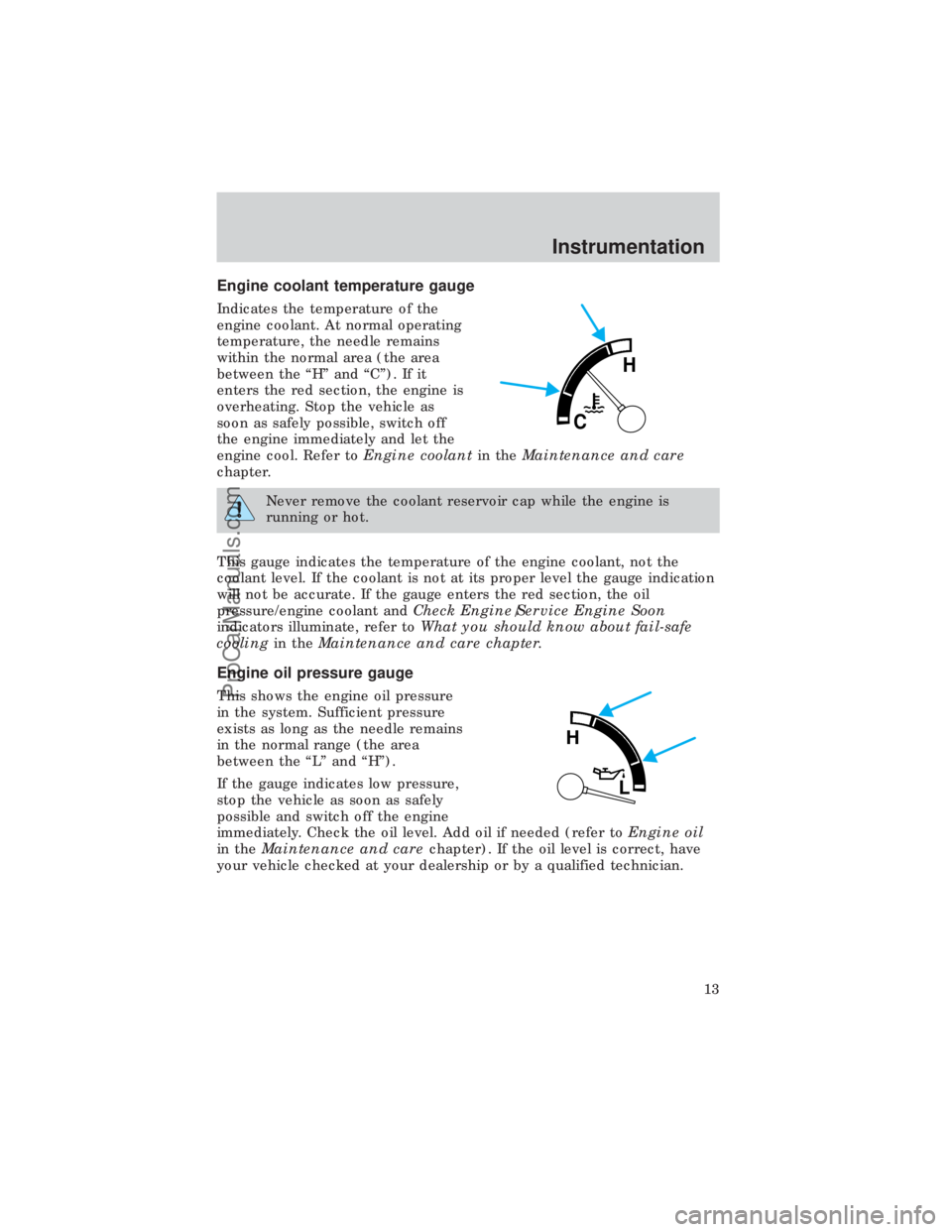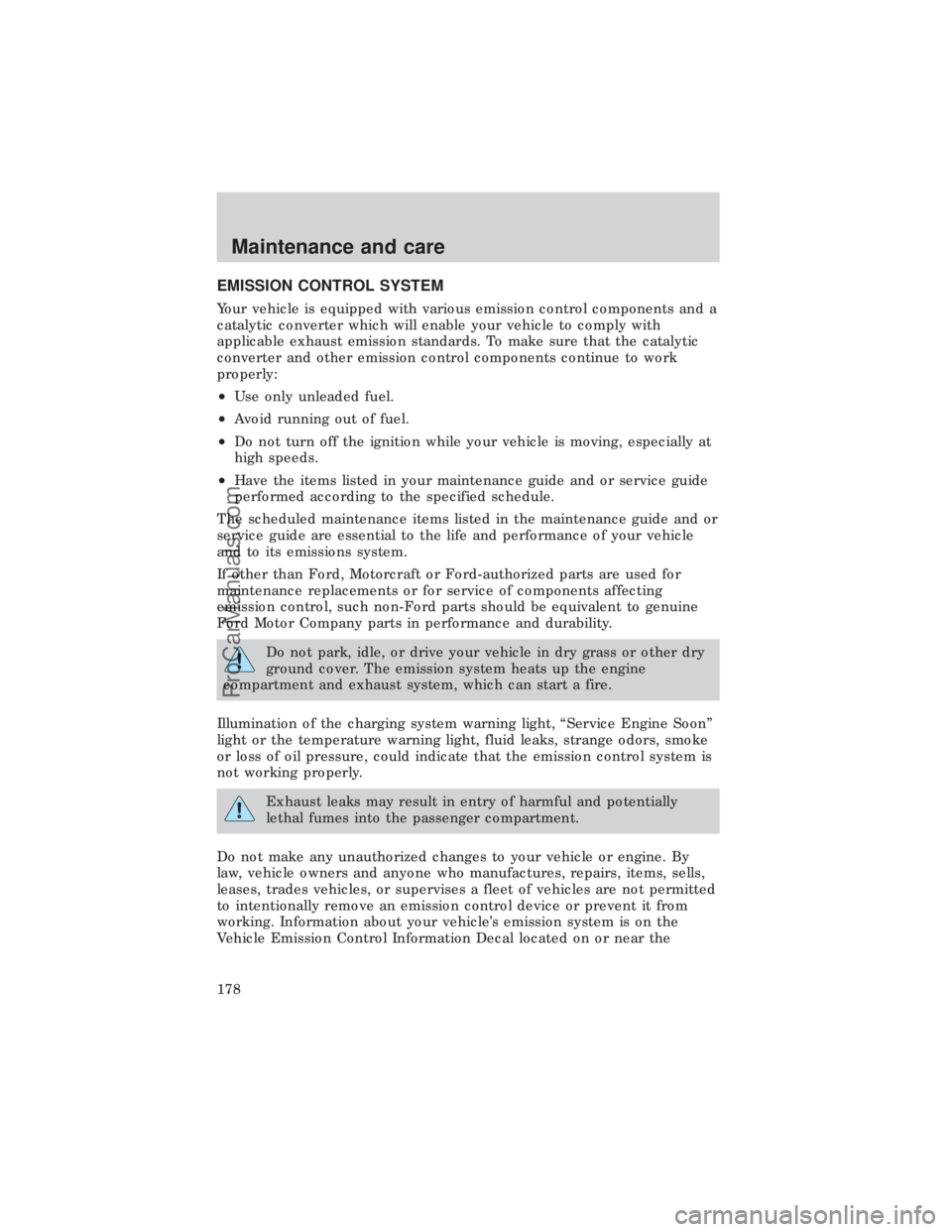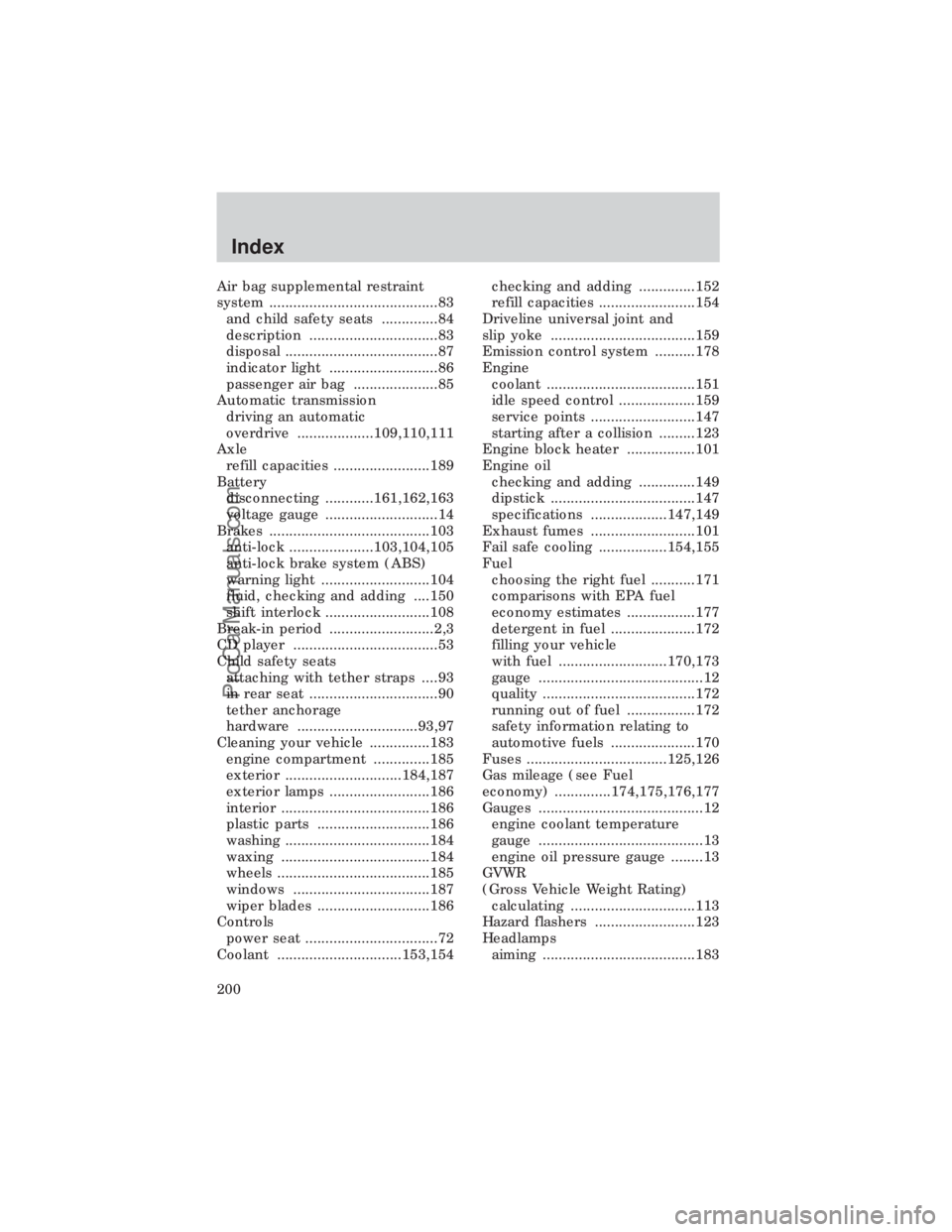1999 FORD E-450 oil temperature
[x] Cancel search: oil temperaturePage 11 of 208

High beams
Illuminates when the high beam
headlamps are turned on.
Oil pressure/Engine coolant
This light will come on when the
key is in the ON position and the:
²engine coolant temperature is
very high
²engine oil pressure is low
The light serves as a notice that a system needs your attention and to
check the engine coolant temperature gauge and the engine oil pressure
gauge.
Refer toEngine coolant temperature gaugeandEngine oil pressure
gaugein this chapter for more information.
Safety belt warning chime
Chimes to remind you to fasten your safety belts.
For information on the safety belt warning chime, refer to theSeating
and safety restraintschapter.
Supplemental restraint system (SRS) warning chime
For information on the SRS warning chime, refer to theSeating and
safety restraintschapter.
Key-in-ignition warning chime
Sounds when the key is left in the ignition in the OFF/LOCK or ACC
position and the driver's door is opened.
Headlamps on warning chime (if equipped)
Sounds when the headlamps or parking lamps are on, the ignition is off
(and the key is not in the ignition) and the driver's door is opened.
Instrumentation
11
ProCarManuals.com
Page 13 of 208

Engine coolant temperature gauge
Indicates the temperature of the
engine coolant. At normal operating
temperature, the needle remains
within the normal area (the area
between the ªHº and ªCº). If it
enters the red section, the engine is
overheating. Stop the vehicle as
soon as safely possible, switch off
the engine immediately and let the
engine cool. Refer toEngine coolantin theMaintenance and care
chapter.
Never remove the coolant reservoir cap while the engine is
running or hot.
This gauge indicates the temperature of the engine coolant, not the
coolant level. If the coolant is not at its proper level the gauge indication
will not be accurate. If the gauge enters the red section, the oil
pressure/engine coolant andCheck Engine/Service Engine Soon
indicators illuminate, refer toWhat you should know about fail-safe
coolingin theMaintenance and care chapter.
Engine oil pressure gauge
This shows the engine oil pressure
in the system. Sufficient pressure
exists as long as the needle remains
in the normal range (the area
between the ªLº and ªHº).
If the gauge indicates low pressure,
stop the vehicle as soon as safely
possible and switch off the engine
immediately. Check the oil level. Add oil if needed (refer toEngine oil
in theMaintenance and carechapter). If the oil level is correct, have
your vehicle checked at your dealership or by a qualified technician.
H
C
H
L
Instrumentation
13
ProCarManuals.com
Page 178 of 208

EMISSION CONTROL SYSTEM
Your vehicle is equipped with various emission control components and a
catalytic converter which will enable your vehicle to comply with
applicable exhaust emission standards. To make sure that the catalytic
converter and other emission control components continue to work
properly:
²Use only unleaded fuel.
²Avoid running out of fuel.
²Do not turn off the ignition while your vehicle is moving, especially at
high speeds.
²Have the items listed in your maintenance guide and or service guide
performed according to the specified schedule.
The scheduled maintenance items listed in the maintenance guide and or
service guide are essential to the life and performance of your vehicle
and to its emissions system.
If other than Ford, Motorcraft or Ford-authorized parts are used for
maintenance replacements or for service of components affecting
emission control, such non-Ford parts should be equivalent to genuine
Ford Motor Company parts in performance and durability.
Do not park, idle, or drive your vehicle in dry grass or other dry
ground cover. The emission system heats up the engine
compartment and exhaust system, which can start a fire.
Illumination of the charging system warning light, ªService Engine Soonº
light or the temperature warning light, fluid leaks, strange odors, smoke
or loss of oil pressure, could indicate that the emission control system is
not working properly.
Exhaust leaks may result in entry of harmful and potentially
lethal fumes into the passenger compartment.
Do not make any unauthorized changes to your vehicle or engine. By
law, vehicle owners and anyone who manufactures, repairs, items, sells,
leases, trades vehicles, or supervises a fleet of vehicles are not permitted
to intentionally remove an emission control device or prevent it from
working. Information about your vehicle's emission system is on the
Vehicle Emission Control Information Decal located on or near the
Maintenance and care
178
ProCarManuals.com
Page 200 of 208

Air bag supplemental restraint
system ..........................................83
and child safety seats ..............84
description ................................83
disposal ......................................87
indicator light ...........................86
passenger air bag .....................85
Automatic transmission
driving an automatic
overdrive ...................109,110,111
Axle
refill capacities ........................189
Battery
disconnecting ............161,162,163
voltage gauge ............................14
Brakes ........................................103
anti-lock .....................103,104,105
anti-lock brake system (ABS)
warning light ...........................104
fluid, checking and adding ....150
shift interlock ..........................108
Break-in period ..........................2,3
CD player ....................................53
Child safety seats
attaching with tether straps ....93
in rear seat ................................90
tether anchorage
hardware ..............................93,97
Cleaning your vehicle ...............183
engine compartment ..............185
exterior .............................184,187
exterior lamps .........................186
interior .....................................186
plastic parts ............................186
washing ....................................184
waxing .....................................184
wheels ......................................185
windows ..................................187
wiper blades ............................186
Controls
power seat .................................72
Coolant ...............................153,154checking and adding ..............152
refill capacities ........................154
Driveline universal joint and
slip yoke ....................................159
Emission control system ..........178
Engine
coolant .....................................151
idle speed control ...................159
service points ..........................147
starting after a collision .........123
Engine block heater .................101
Engine oil
checking and adding ..............149
dipstick ....................................147
specifications ...................147,149
Exhaust fumes ..........................101
Fail safe cooling .................154,155
Fuel
choosing the right fuel ...........171
comparisons with EPA fuel
economy estimates .................177
detergent in fuel .....................172
filling your vehicle
with fuel ...........................170,173
gauge .........................................12
quality ......................................172
running out of fuel .................172
safety information relating to
automotive fuels .....................170
Fuses ...................................125,126
Gas mileage (see Fuel
economy) ..............174,175,176,177
Gauges .........................................12
engine coolant temperature
gauge .........................................13
engine oil pressure gauge ........13
GVWR
(Gross Vehicle Weight Rating)
calculating ...............................113
Hazard flashers .........................123
Headlamps
aiming ......................................183
Index
200
ProCarManuals.com